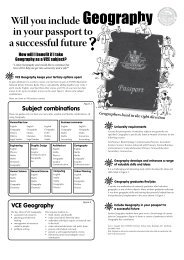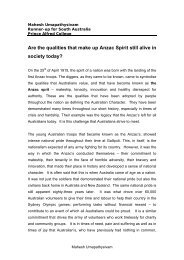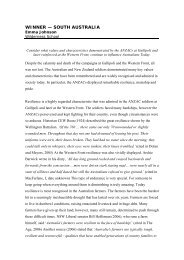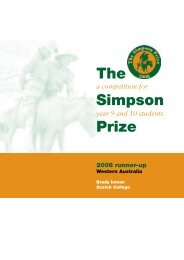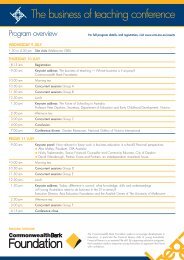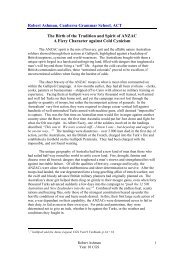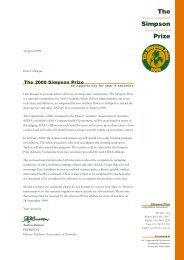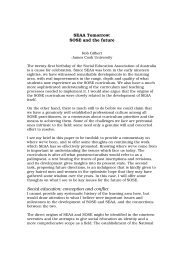RUNNER-UP â AUSTRALIAN CAPITAL TERRITORY - afssse
RUNNER-UP â AUSTRALIAN CAPITAL TERRITORY - afssse
RUNNER-UP â AUSTRALIAN CAPITAL TERRITORY - afssse
You also want an ePaper? Increase the reach of your titles
YUMPU automatically turns print PDFs into web optimized ePapers that Google loves.
<strong>RUNNER</strong>-<strong>UP</strong> — <strong>AUSTRALIAN</strong> <strong>CAPITAL</strong> <strong>TERRITORY</strong>Angus PfahlCanberra Grammar SchoolConsider what values and characteristics demonstrated by the ANZACs at Gallipoliand later reinforced at the Western Front, continue to influence Australians today.Through their sacrifice the ANZAC warriors of the First World War, planted the seedof beginnings for the nation of Australia. It was their spirit, their mateship, theircourage and their humour that turned Australia from a nation of immigrants, to one inits own right. The Battle of Gallipoli and later the Western Front Campaign provedvery much a baptism of fire for the young ANZACs, a battle that was virtuallyimpossible. But through their spirit our nation had gained much more than a singlemilitary victory could give us. The ANZAC legends had laid the foundations for thenation of Australia with their traits which continue in Australian society today.“We Will Make a Name for Ourselves and Australia Tomorrow Mac.” 1 – Alfred ShoutThe night preceding the Battle of Lone Pine, Captain Alfred Shout sat in the trenches,unaware of what card fate would deal him the following day. He certainly did make aname for himself, but far more importantly he made a name for Australia. As Gallipolis’smost decorated War Hero, Shout can as much as anyone be attributed with creating theimage of the courageous ANZAC. Two days after the tragic battle of Lone Pine, Turkishtroops forcefully counter-attacked. At one section, later known as Sasse’s Sap, CaptainCecil Sasse, Shout and eight volunteers, began to push forward, Sasse shooting, Shoutbombing and the volunteers creating safety barriers at each newly claimed area. Shout inone last push lit three bombs, and rushed forward at the mercy of the Turkish gunfire.Two were released; however the final blew in his hand, the injury that would kill him. Forhis efforts he was awarded Australia’s highest recognition of bravery, The Victoria Cross.“A man crawled out of our shallow trench … worked his way snake-wise until he gotto the wounded man. Clumsily turning the man over he shouted, "How's she going,1 Macqueen, Cpl. 16 Nov. 2006 .
mate?". There was no answer. He yelled, "Strike me pink the poor bugger's just aboutouted", and began to drag him... he got a bullet through his ankle but managed it atlast and we cheered him. He looked over and grinned.” – Private Percival 2While awe inspiring efforts such as Shout’s have become folklore, nothing hasreached the level of the collective spirit of the ANZACs at Gallipoli. Gallipoli was nota time for individuals, the true sense of mateship was that which pushed men on.Private Percival in describing his brother’s injury, and ensuing death, showed howpowerful a tool this spirit was. Men went out there to fight, for themselves, for theircountry, but most importantly for their mates. It was this which drove the men to getup every morning when all hope of victory seemed lost.Charles Bean in his Official History of Australia in the War of 1914-1918, talksglowingly of this spirit amongst men. Many say that he himself can be largelycredited witht the spread of the legend through his patriotic writings.“To be the sort of man who would give way when his mates were trusting to hisfirmness … to live the rest of his life haunted by the knowledge that he had set hishand to a slodier’s task and had lacked the grit to carry it through – that was theprospect that these men could not face. Life was very daer, but life was not worthliving unless they could be true to their idea of Australian manhood.” 3 – C.E.W BeanThe aspect of humour is one that most Aussies look at with the greatest of pride. Tobe in a situation as horrific as the one detailed and to be able to have a laugh is aspecial and admirable characteristic. A laugh at the mates, at themselves, or even thePoms is something that was so important in both pushing the men forward, but also indeveloping the likeable image of Australians across the world.These characteristics of bravery, mateship, and humour forged by the efforts of themen at Gallipoli and on the Western front, and those women who attended them, wereof such power that they remain a notion of Australian society today. During the time2 “Mateship." 7 July 1915. 16 Nov. 2006 .3 Bean, C.E.W. The Story of Anzac. Sydney: Angus & Robertson, 1941.
of the war the ANZAC legend was said to be very much a self fulfilling one, the morethe men heard it the more they lived up to it. This is very much the same today, thepride Australians have in the heroes of war, as shown by recent attendances at dawnservices across the nation, show the legend lives on.Pride and fulfilment of this can come across in many different ways, and it would benaïve to suggest Australia remains a country of ‘gutsy, larrikin blokes.’ Globalisationhas broken down many barriers of a national identity, but every Australian should notforget the pride of the defining moment in our history.It is said that in crisis the true strands of human nature are revealed. For the ANZACsat Gallipoli, farmers, bankers, fathers, boys were brought together and forced to worktogether. This image was further forged on the Western Front, and later the SecondWorld War, and continues today.In Australian society, crisis brings people together, they act on their instincts, and notnecessarily how they usually perceive themselves. Charity efforts, and publicoutpouring of prayers and love for such horrible events as the Bali Bombings and theBoxing Day Tsunami, have bought people together, showing the greatest of ties ofmateship.One such disaster was the Beaconsfield Mine Collapse in Tasmania. Brant Webb andTodd Russell were trapped underground for two weeks, with the Australian public ina sense of shock yet also one of hope. The bravery showcased by these two men, andthose who risked their lives to save them, was phenomenal. However what made thechapter so special was the character that these two men displayed throughout. Russelljoked "It's not much of a room we have up here,” before saying he must find a newjob. The character these two men showed when presented with adversity was a trueindication of the ANZAC image, or what we may now call the Australian image.In the wider society as well people show the traits and values of the ANZAC. Love isan extremely important value that is perhaps often overlooked in our portrayal of theANZAC. However just as it is vital to life today, it was to the men on the battlefield.A loss of an Australian life is felt by everyone, just as an Australian acheivment is.
We are an incredibly proud people, bred from years of isolation and a growing selfidentity. We are drawn together by ties of mateship. We constantly prove in times oftoughness our bravery shines through. And finally, we all love a laugh.How Australians are percieved overseas is as important to the people of societytoday, as it was for the ANZACs. A unique character, something to be proud of, isvital part of self knowing in an increasingly distant world. The Aussie larikkin liveson today. All across the world people recognise Aussies by the same traits as theDiggers showed in the War Campaign, a true testament to the fact that the spirit livestoday.The First World War campaign can be seen as the foundations of what it means to beAustralian. While we have changed greatly, the ANZAC traits of bravery, mateship,and humour are everpresent today. Australians look back at those heroes of the FirstWorld War campaign with the greatest sense of pride and gratitude. It was there spiritthat created a beginning for our nation, and it is that same spirit which continues todetermine our future today.Word Count: 1118Bibliography:• Ashmead-Bartlett, Ellis. Argus. 1915. 19.• Bean, C.E.W. The Story of Anzac. Sydney: Angus & Robertson, 1941 .• Pugsley. C., The ANZACs At Gallipoli, 2000, Thomas C. Lothian, Melbourne.• “Beaconsfield Mine Collapse." Wikipedia. 11 Nov. 2006. 16 Nov. 2006.• “Ex Service Organisation ANZAC Day Speeches” Macqueen, Cpl. 16 Nov. 2006.• “Mateship." 7 July 1915. 16 Nov. 2006.
• “Tribute to the Anzac Legend." The Age. 25 Apr. 2005. 16 Nov. 2006.




